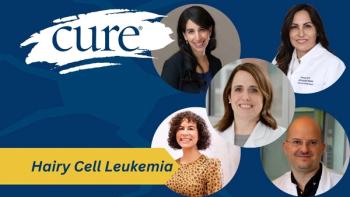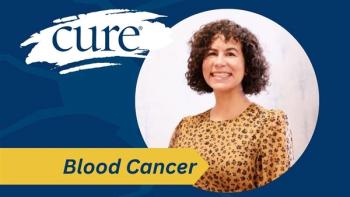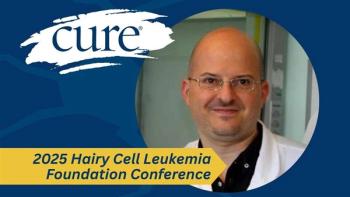
- Hematology Special Issue
- Volume 1
- Issue 1
Some Pediatric Regimens Can Be Successful in Adults With ALL
A study of acute lymphoblastic leukemia across the age spectrum is showing that some pediatric regimens can be successful in adults.
When Jody Winsick-Soluri was diagnosed with acute lymphoblastic leukemia (ALL), she found out she had a chromosomal abnormality, the Philadelphia chromosome, which made her prospects bleak.
“I was bleeding out; they said I might only have 24 hours to live,” Winsick-Soluri remembers. Now, after many rounds of chemotherapy, total body irradiation, two bone marrow transplants and seven years, Winsick Soluri takes a targeted drug — Sprycel (dasatinib) — that blocks a protein leukemia cells need to proliferate. “Now, I’m four-and-a-half years out from the last transplant,” the New Jersey mother of four says. “More people with ALL are staying alive a lot longer.”
Jeremy Katzman was 21 and a junior at the University of Florida when he was diagnosed with ALL. Though technically an adult, Katzman’s medical team suggested that he undergo a longer, more aggressive pediatric protocol to treat his disease, a new idea at the time. Twelve years later, he’s disease-free. “I’m glad I did it. Knock on wood, I’m doing OK,” says Katzman, now 33 and the father of a toddler.
Leukemia became the first great success story of cancer treatment when the earliest chemotherapy drugs were used to treat children with the disease in the late 1940s. Since then, new chemotherapy drugs and regimens have developed, but the basic idea behind the treatment — several long courses of aggressive chemotherapy — has remained largely the same, experts say. So has the general separation between pediatric cases of ALL and adult cases, both in research and in treatment.
Because of patients like Winsick-Soluri and Katzman, however, those lines are beginning to blur. Experts say we are now poised to investigate the biology of ALL across an age spectrum from 1 to 50. At the Dana-Farber Cancer Institute, for instance, there is a combined Adult- Pediatric ALL Consortium; similar groups are convening worldwide.
Adults — for whom a typical past strategy was to take chemotherapy until their disease was well enough controlled for a bone marrow transplant — may now follow programs inspired by pediatric treatment: several courses of intense chemotherapy that may go on for two to three years. And other teams are beginning to better understand the biology of ALL, using therapies that enlist the patient’s immune system and targeted agents like the one that makes such a difference for Winsick-Soluri.
“I think it’s an exciting time now. Several things are happening: Our knowledge of the biology is improving, and also the technology. We are developing new ways of treating ALL, and specialists in pediatric and adult ALL are working together much better,” says Dr. Sima Jeha, a pediatric ALL specialist at St. Jude Children’s Research Hospital in Memphis, Tennessee.
UNDERSTANDING ALL
ALL is an aggressive type of leukemia characterized by a rapid growth of lymphoblasts that take over the blood-making bone marrow, and commonly enter the bloodstream as well. A lymphoblast is an immature cell that has the potential to develop into several kinds of white blood cells: plasma cells that help transport nutrients, hormones and proteins around the body, as well as T lymphocytes and “natural killer cells” that make up part of the body’s immune system arsenal. However, in ALL, the lymphoblasts do not mature to develop into these specialized cells.
As is the case with many cancers, experts are learning that ALL isn’t really a single disease. It seems, instead, to be a group of related diseases with different biomarkers and subtypes. Treatment and prognosis can vary widely depending on subtype, age, each individual’s reaction to treatment and other factors.
“ALL is not one disease, it’s a cluster of diseases,” says Jeha. “It varies with age, with subtypes, and you need to tailor the therapy to make it personalized and directed. It’s not one size fits all.”
“There appear to be complex biological differences between pediatric and adult ALL, and we are just starting to unravel these in the laboratory. Hopefully, we can exploit the different mutations, signaling pathways and surface antigens as druggable targets. Even knowing that, we don’t fully know what the answer is,” explains Gail Roboz, professor of medicine and director of the Leukemia Program at Weill Cornell Medical Center in Manhattan.
Differences in the biomarkers on cells, or changes in different chromosomes (such as the Philadelphia chromosome in which genetic material switches places, moving from chromosome 22 to chromosome 9), pre-existing Down’s syndrome or differences in cell shape can greatly affect how a person responds to ALL treatment.
Fortunately, childhood cancer is rare. But among those who do experience a childhood malignancy, ALL is the most common, representing about 25 percent of cancer cases in patients younger than 15. Hispanic and Caucasian kids seem to suffer greater incidence of ALL than do African- American kids. Among adults, however, ALL occurs much more infrequently compared with other cancer types.
Prognosis is also different. Most children treated for ALL, as many as 90 percent, will achieve a cure or a long period without recurrence of disease. The outlook, though, seems to dim the older patients get: Older pediatric patients seem to do worse than younger ones. And younger adult patients do better than those who are older. The overall survival rate for adults under 65 hovers around 40 to 50 percent.
Doctors say that some of these differences may arise from practicalities and culture: Pediatric ALL is common, and most kids are treated in large medical centers with multidisciplinary teams closely managing complex treatment protocols. About 90 percent of these patients are enrolled in clinical trials. Adult ALL is more rare, and many adults are not treated at large medical centers. Most do not participate in clinical trials. Children usually have activist caregivers, usually their mothers. Adults often do not.
“Kids have fierce mothers on their side. But adults are generally supposed to take responsibility,” says Jeha.
But there may also be a biological component that we don’t yet understand. For instance, children who have ALL that primarily affects immune T cells tend to have worse outcomes than children whose ALL affects mainly B cells. The situation is the reverse in adolescents and adults, with T cell disease tending to improve prognosis.
ALL usually comes on quickly, within days or weeks. The most common symptoms are fatigue from low red blood cell counts, bruising and/or bleeding due to low platelet counts and infection because of low counts of white blood cells, the foot soldiers of the immune system. The proliferation of leukemia cells causes the failure of bone marrow, where blood cells develop.
BLURRED LINES
The general idea behind treatment is to overwhelm the cancer cells with toxic agents, usually chemotherapy regimens that may continue for two, even three years. The treatment is complicated, and involves a large team of medical specialists and long hospital stays.
Because ALL is a blood cancer — with the cancer cells in constant motion in the bloodstream — surgery and radiation are not as common in ALL treatment as they are in patients with solid tumors.
Many drugs used for ALL have been around for more than four decades, and experts say that until recently, the standard treatment for ALL hadn’t changed that much in 15 years. It’s usually several chemo drugs, the most common agents being vincristine, daunorubicin, cytarabine, asparaginase, etoposide, teniposide, methotrexate, cyclophosphamide, prednisone and dexamethasone. Depending on subtype, age and other factors, each patient will be given different combinations of these drugs, usually administered in the following progression over approximately two years:
> “Induction” chemotherapy, designed to eradicate cancer cells from the blood and bone marrow.
> “Consolidation” chemotherapy, designed to strengthen the defenses against the cancer (also to eradicate residual disease).
> “Maintenance” chemotherapy, which may continue for one or two years, designed to keep the cancer at bay (and also to deal with microscopic residual disease, or “sanctuary sites”).
Since the nervous system is often involved in ALL progression, and this area is difficult to effectively treat with chemotherapy, most patients are also given treatments to protect the nervous system. A lumbar puncture can be used to test for central nervous system involvement — that is, leukemia cells in spinal fluid or the brain — which usually means a poorer prognosis.
If the patient doesn’t seem to be responding to any of these measures, a stem cell/bone marrow transplant — an arduous procedure in which the patient’s bone marrow is killed off so that it can be replaced with healthy cells — may be done if the patient is healthy enough to tolerate it.
Within this general structure, though, there are clear differences between adult and pediatric treatment. Kids usually get a dose-dense, aggressive course of chemotherapy, which may be too toxic for some adults. Stem cell transplant is often a treatment of last resort for kids. In adults, who are more likely to have genetic glitches or disease subtypes that spell a poor prognosis — stem cell transplant may be the go-to treatment for many patients once the first round of chemotherapy has achieved remission.
Yet experts say that little is known about what the ideal chemotherapy dose is for particular patients, or how individual patients may metabolize drugs differently. For instance, in adults, the time necessary to achieve the first remission doesn’t seem to affect outcomes. But in children, the difference — does it take one month or two months? — seems to be a matter of life and death for those who respond slowly.
Also, doctors are now beginning to question whether early stem cell transplant in adults is really the best alternative. Some suggest that the larger number of treatment-related deaths in adult patients actually may be linked to those harrowing stem cell or bone marrow transplants.
In the past, it was thought that adults could not tolerate the most toxic chemotherapy agents used on children, asparaginase usually given as the main example of this. Yet recent studies show that adults and children have similar rates of problems with this drug. It remains a topic of debate.
Yet more and more ALL protocols for grownups are being inspired by the lessons learned in pediatric ALL. The “Berlin-Frankfurt-Munster Protocol” in Germany, the “Larson Protocol” at University of Chicago, the “Dana-Farber Cancer Institute Protocol” at Harvard — all these regimens are inspired by pediatric strategies.
Besides the typical side effects that are associated with chemotherapy, there are an array of additional symptoms, some of them long-term, that can arise from treatment for ALL: fatigue; lower resistance to infection or, more rarely, lung problems following transplant; infertility or, less commonly, heart problems due to chemotherapy and/or radiation; thyroid problems due to radiation; and, infrequently, second cancers.
It’s true that these side effects can greatly affect quality of life, but the fact that a growing population of ALL survivors is around to work through them is leaving doctors feeling hopeful.
“In pediatrics, the cure is so common now that the focus is more and more on quality of life,” explains Jeha of St. Jude.
“The good news is that more and more people are surviving, so we’re getting more questions about long-term survivorship,” says Beatrice Abbetti, who directs the Leukemia and Lymphoma Society’s Information Resource Center, a service that fields 40,000 patient inquiries annually.
A TARGETED APPROACH
Luckily, new, more targeted drugs, and drugs that enlist the patient’s own immune system, seem to be less toxic than the traditional aggressive chemotherapy. These help all ALL patients, but seems poised to make a big difference for adults.
The first breakthrough came in 2001, with Gleevec (imatinib), a tyrosine kinase inhibitor (TKI) initially approved for chronic myeloid leukemia that turned out to help patients like Winsick-Soluri who have the Philadelphia chromosome (seen in about 20 to 30 percent of adult ALL), by interrupting signals those cells need to divide. Patients show good response rates initially, but by the three-year mark, only 60 percent of these patients survive. Recently, a study that combined chemotherapy with a new TKI called Iclusig (ponatinib) showed overall survival of 80 percent at the two-year mark.
Researchers also have begun to develop monoclonal antibodies that target certain markers on the surface of leukemia cells. Adding Rituxan (rituximab), which targets the CD20 antibody, to chemotherapy has become the standard of care for ALL patients who have newly diagnosed, CD20-positive, Philadelphia chromosome-negative B-cell precursor ALL. In the last year, Blincyto (blinatumomab), which aims at two targets, CD3 and CD19, and inotuzumab ozogamicin, which aims at CD22, have shown good results in adults who have relapsed. For instance, Blincyto achieves remission for 36 percent of those with the Philadelphia chromosome and ro 80 percent of those without. In the past, there have not been many options for these people.
Even more striking have been results with CAR T cell therapy. CARs (chimeric antigen receptors) are proteins that allow immune system T cells to recognize a specific antigen on the surface of B cells, immune cells commonly involved in ALL. The patient’s own T cells are modified, then grown into the billions and re-introduced into the bloodstream. Though it’s still early days for this technique, small trials have shown a 100 percent complete remission in pediatric patients who’ve relapsed. It’s also been shown to prevent complications after bone marrow transplant.
“We’re opening a completely new set of doors for ALL. Patients who couldn’t get a transplant, patients who’ve relapsed, we are beginning to cure these leukemias,” says Swaminathan Iyer, a Houston hematologist affiliated with Houston Methodist Hospital. “We will get to pediatric ALL responses in adults, but it will take time."
Articles in this issue
over 9 years ago
Plotting a New Course in Multiple Myelomaover 9 years ago
Medical Illustration: Multiple Myelomaover 9 years ago
Keeping Advocacy at the Forefront




